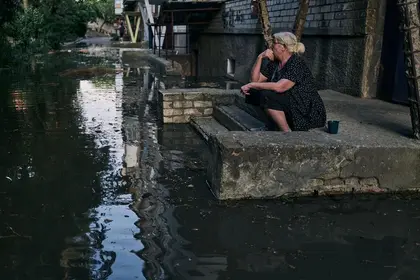Another case for The Hague
JOIN US ON TELEGRAM
Follow our coverage of the war on the @Kyivpost_official.
For The Times Putin's signature is clearly visible:
“Vladimir Putin's regime has deliberately targeted civilian lives and infrastructure in its war of aggression against Kyiv since February last year. Though reliable information is as yet scarce, it would be in keeping with this strategy for Russia to blow up the dam, heedless of the danger to civilian lives in villages and towns that now adjoin the Dnipro river, in order to prevent a crossing by Ukrainian forces. The bombing and consequent flooding provide a sobering backdrop to a case that began yesterday at the International Court of Justice (ICJ) at the Hague, in which Ukraine accuses Russia of being a terrorist state.”
Flooded earth strategy
If blowing up the dam was a Russian tactic, it is not a very good one, Le Figaro explains:
“The destruction will have negative repercussions for both camps: on the Ukrainian side it will pose a serious threat to the civilian population and delay the launch of the counteroffensive; on the Russian side it will jeopardise Crimea's water supply and the strength of the defence lines . ... There have been numerous precursors for the scorched-earth strategy in this area, and the current flooded-earth strategy is yet another variant. It indicates that the warring parties will not shy away from any kind of escalation in the struggle to defeat the enemy. But the Russians should know by now that such a strategy always ends in the defeat of the aggressor.”

German Opposition Slams Exclusion of Poland From Berlin Talks on Ukraine
Prioritise demining around Zaporizhzhia
While the situation at the Zaporizhzhia Nuclear Power Station is not threatening right now, one question needs to be urgently clarified, expert Olga Kozharna points out in NV:
“The power units have been shut down since September 2022. Hence they require less water for cooling than when the plant is running at full capacity. So there are risks, but the situation is stable. In addition, mobile pumping units with hoses up to 2 km long were installed at the power plant after the accident in Fukushima. ... The problem, however, is that the Russian occupiers have mined the shore and the area around the plant. I hope they managed to record the locations of the mines on maps. Because to bring these mobile pumping units to the banks of the Dnipro the area must be cleared of mines.”
Propaganda and playing the blame game
Both parties stand to gain from the breach, the Oberösterreichische Nachrichten concludes:
“For the time being, all we know is that the dam has been destroyed. But then the propaganda begins. And as always in this war, no one wants to take responsibility. So the only way to find the truth is to work with plausibilities. Russia, for example, would have the advantage that Ukraine is now focused on repairing the damage and has to postpone its major offensive. Ukraine, on the other hand, can rejoice that the drinking water supply of occupied Crimea is now at risk, which is a bitter blow for the Kremlin.”
Water as the best defence
In a Telegram post republished by Echo, political scientist Abbas Galliamov suspects this was the deliberate destruction of ineffectual defensive positions:
“If these fortifications were of roughly the same quality as those through which the Russian Volunteer Corps and the Freedom of Russia Legion passed like knives through butter in Belgorod, it was essential to flood them. To avoid disgrace. ... Once the water has receded Putin's generals can safely withdraw, because they now have an alibi against the wrath of their superiors: of course we wouldn't have left, but the damned Dnieper destroyed our elaborate fortifications. Otherwise never! ... And at least for the time being, the water is the best barrier against the advancing enemy.”
Precision strike gone wrong?
Onet is surprised about the information chaos on the Russian side:
“At first glance, the whole thing seemed like an attempt by the Russians to seize the operational initiative. During the night, Russian missiles attacked Kyiv and Kharkiv. In the morning, the FSB warned of alleged Ukrainian plans to use a dirty bomb. The blowing up of the dam could thus be part of a larger operation. However, the Russian account was chaotic from the outset, which suggests that the Russians could have been caught off guard by the events. ... The information chaos could indicate that the Russians only wanted to blow up part of the dam as part of a 'precision strike' to flood the islands at the mouth of the Dnipro River where Ukrainian troops are stationed - but in the end it turned out as it always does.”
You can also highlight the text and press Ctrl + Enter






